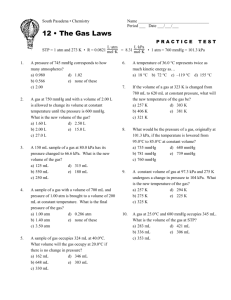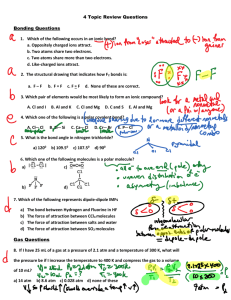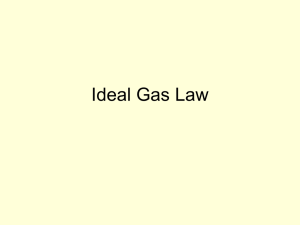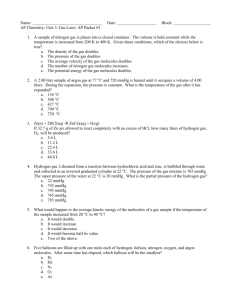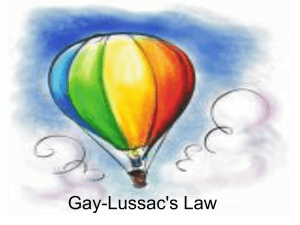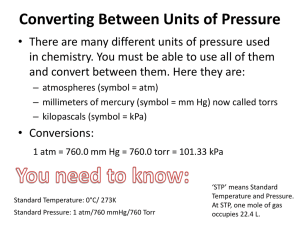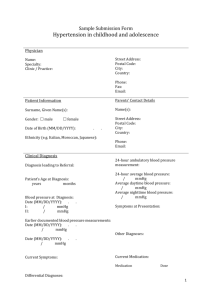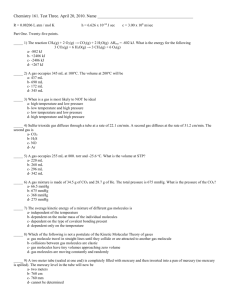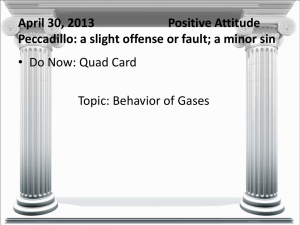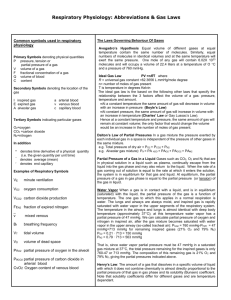Gas Laws - ISAKanyakumari
advertisement
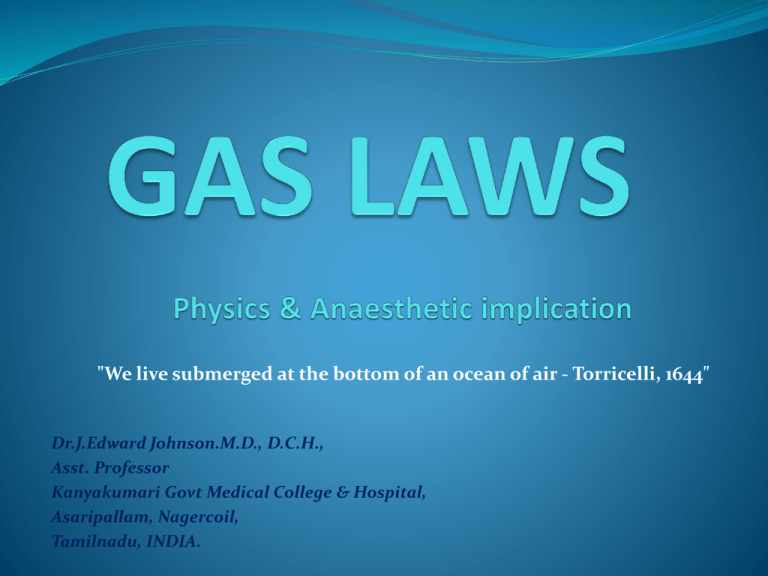
"We live submerged at the bottom of an ocean of air - Torricelli, 1644" Dr.J.Edward Johnson.M.D., D.C.H., Asst. Professor Kanyakumari Govt Medical College & Hospital, Asaripallam, Nagercoil, Tamilnadu, INDIA. Molecular Theory Van der Waals forces Lattice (oscillates) •All matter is made of tiny particles called atoms. •These atoms are in constant motion Brownian motion (random motion). • Each particle has kinetic energy. • Collisions between particles are perfectly elastic. Interface Pressure Saturated Vapour Pressure The Gas Laws Introduction 1. Definitions: Pressure = force/area P = F/A 2. Units: • Pascal (Pa): 1 Pa = 1 Newton/m2 or 1N/m2 The Pascal is the Standard International Unit of pressure The Newton is the Standard International Unit of force •Atmosphere (atm): one atm =101325 Pa •Pounds per sq inch (psi): one atm = 14.7 psi or lbs/in2 •Torricelli (torr): one atm = 760 torr mmHg: 1 mmHg = 1 torr •Millimeters Hg: one atm = 760 mmHg 1 atm = 14.7 psi = 760 mmHg = 101 kPa In the Torricellian tube, the atmospheric pressure supports, mercury 760 mm tall Pressure P= f/a Pressure is inversely proportional to area 20ml 1 atm 10ml 2 atm Pressure P= f/a Anesthesia Machine Examples Pressure Relief Valve Expiratory Valve Pressure-reducing valve AKA pressure regulator Oxygen Failure warning device Comparison of Variables & Constants in Gas Laws Variables allowed to change Variables held constant Resulting relationship Formal designation Pressure and Volume Number of molecules and Temperature P1V1 = P2V2 Boyle's Law Volume and Temperature Number of molecules and Pressure V1/T1=V2/T2 Charles' Law Pressure and Temperature Number of molecules and Volume P1/T1=P2/T2 Amonton's Law Number molecules and Volume Pressure and Temperature V1/n1=V2/n2 Avogadro's Law Pressure, Volume, & Temperature Number of molecules P1V1/T1=P2V2/T2 Combined Gas Law P1V1/n1T1=P2V2/n2T2 Ideal Gas Law Pressure, Volume, Temperature & Number of molecules -- Boyle’s Law (Pressure – Volume Law) The volume of a given amount of gas at a constant temperature varies inversely with the pressure P1V1 = P2V2 Graph of pressure vs. volume for a gas enclosed in a cylinder at constant temperature (Boyle's law) Example - Cylinders For example, if we have a cylinder of gas under pressure equivalent to 13,800 kPa (the internal volume or capacity of the cylinder is about 10 liters), how much gas would be available at atmospheric pressure which we will say is about 100 kPa. Cylinder Atmosphere P2 100 kPa P1 13,800 kPa V2 V1 10 liters P1V1 = P2V2 13,800 x 10 = 100 x V2 V2 = 13,800 x 10 100 V2 = 1380 lts ? Charles’ Law (Temperature-Volume Law) Gas volume varies directly with temperature at a constant pressure V1/T1=V2/T2 Remember, always use degrees Kelvin for temperature representation Amontons' Law of Pressure-Temperature Gas pressure varies directly with temperature at a constant volume P1/T1=P2/T2 Gay-Lussac Law Law of combining volumes The ratio between the volumes of the reactant gases and the products can be expressed in simple whole numbers. STP- 273.15˚ k(0˚C) - 101kPas(760mmHg) Pressure-Volume-Temperature Relationships “Pay TV Can Be Good” Pay- Can Pressure constant-Charles Temperature constant-Boyles T - Be V - Good Volume constant- GayLussac Avogadro's Law For a given mass of an ideal gas, the volume and amount (moles) of the gas are directly proportional if the temperature and pressure are constant. Avogadro's Law “Equal volumes of any two gases at the same temperature and pressure contain the same number of molecules.” V∝ n (at constant T and P) One mole of any gas contains the same number of molecules (Avogadro's number =6.02×1023) Gram molecule H2 (mass of gas) O2 Same number of molecules in one gram molecule H2O 2H2+O2=2H20 Ideal Gas Law (Universal Gas Law) Under the same condition of temperature and pressure, equal volumes of all gases contain the same number of molecules. He N2 O2 Calibration of Vaporizers One mole of Gas At STP Mol.wt of Iso – 184.5 184.5 gm of Iso = 1 mol O2 224 L O2 + Isoflurane Isoflurane 18.45gm 0.1 mol 2.24 L 2.24 = 1% 224 Calculation of volume of Nitrous Oxide gas Mol. Wt of N2O - 44 1 mol = 44 gm 3.4kg 44 gm(1mol) occupies = 22.4 L 3400 gm occupies = 22.4 x 3400 = 1730 L 44 Combined gas law The combined gas law is a gas law which combines Charles's law, Boyle's law, and Gay-Lussac's law Combined gas law Dalton’s Law of Partial Pressures The total pressure exerted by a mixture of gases is the sum of their individual partial pressures PARTIAL PRESSURE of AIR Partial Pressure (mmHg) Inhaled Alveolar Exhaled GAS Nitrogen Oxygen CO2 H2O vapor TOTAL 594.70 160.00 0.30 570 103 40 569 116 28 5.00 47 47 760 760 760 Ptotal = Pa + Pb + Pc + etc Dalton’s Law of Partial Pressures Entanox Cylinders Dalton’s Law of Partial Pressures • What is the partial pressures of O2 and N2O if you are administering a ratio of 70/30? • N20 70% X 760 mmHg = 532 mmHg O2 30% X 760 mmHg = 228 mmHg 760 mmHg • Would this differ if you were administering anesthesia at Denver General Hospital? • N20 70% X 630 mmHg = 441 mmHg O2 30% X 630 mmHg = 189 mmHg 630 mmHg Miami Miami = 760mmHg = 14.7 psi Denver = 630mmHg 12.2 psi Adiabatic heating and cooling Adiabatic changes in temperature occur due to changes in pressure of a gas while not adding or subtracting any heat Cryoprobe – N2O or CO2 Critical Temperature As the substance approaches critical temperature, the properties of its gas and liquid phases converge, resulting in only one phase at the critical point Critical Temp of N2O = 36.5˚C Critical Temp of O2 = -119 ˚C

